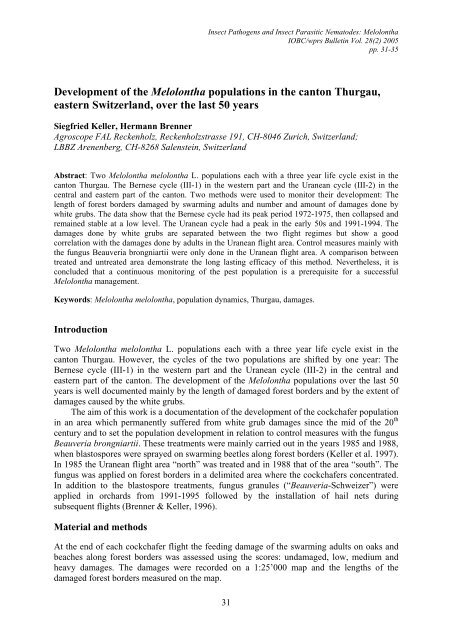IOBC/wprs Bulletin Vol. 28(2) 2005
IOBC/wprs Bulletin Vol. 28(2) 2005
IOBC/wprs Bulletin Vol. 28(2) 2005
You also want an ePaper? Increase the reach of your titles
YUMPU automatically turns print PDFs into web optimized ePapers that Google loves.
Insect Pathogens and Insect Parasitic Nematodes: Melolontha<br />
<strong>IOBC</strong>/<strong>wprs</strong> <strong>Bulletin</strong> <strong>Vol</strong>. <strong>28</strong>(2) <strong>2005</strong><br />
pp. 31-35<br />
Development of the Melolontha populations in the canton Thurgau,<br />
eastern Switzerland, over the last 50 years<br />
Siegfried Keller, Hermann Brenner<br />
Agroscope FAL Reckenholz, Reckenholzstrasse 191, CH-8046 Zurich, Switzerland;<br />
LBBZ Arenenberg, CH-8268 Salenstein, Switzerland<br />
Abstract: Two Melolontha melolontha L. populations each with a three year life cycle exist in the<br />
canton Thurgau. The Bernese cycle (III-1) in the western part and the Uranean cycle (III-2) in the<br />
central and eastern part of the canton. Two methods were used to monitor their development: The<br />
length of forest borders damaged by swarming adults and number and amount of damages done by<br />
white grubs. The data show that the Bernese cycle had its peak period 1972-1975, then collapsed and<br />
remained stable at a low level. The Uranean cycle had a peak in the early 50s and 1991-1994. The<br />
damages done by white grubs are separated between the two flight regimes but show a good<br />
correlation with the damages done by adults in the Uranean flight area. Control measures mainly with<br />
the fungus Beauveria brongniartii were only done in the Uranean flight area. A comparison between<br />
treated and untreated area demonstrate the long lasting efficacy of this method. Nevertheless, it is<br />
concluded that a continuous monitoring of the pest population is a prerequisite for a successful<br />
Melolontha management.<br />
Keywords: Melolontha melolontha, population dynamics, Thurgau, damages.<br />
Introduction<br />
Two Melolontha melolontha L. populations each with a three year life cycle exist in the<br />
canton Thurgau. However, the cycles of the two populations are shifted by one year: The<br />
Bernese cycle (III-1) in the western part and the Uranean cycle (III-2) in the central and<br />
eastern part of the canton. The development of the Melolontha populations over the last 50<br />
years is well documented mainly by the length of damaged forest borders and by the extent of<br />
damages caused by the white grubs.<br />
The aim of this work is a documentation of the development of the cockchafer population<br />
in an area which permanently suffered from white grub damages since the mid of the 20 th<br />
century and to set the population development in relation to control measures with the fungus<br />
Beauveria brongniartii. These treatments were mainly carried out in the years 1985 and 1988,<br />
when blastospores were sprayed on swarming beetles along forest borders (Keller et al. 1997).<br />
In 1985 the Uranean flight area “north” was treated and in 1988 that of the area “south”. The<br />
fungus was applied on forest borders in a delimited area where the cockchafers concentrated.<br />
In addition to the blastospore treatments, fungus granules (“Beauveria-Schweizer”) were<br />
applied in orchards from 1991-1995 followed by the installation of hail nets during<br />
subsequent flights (Brenner & Keller, 1996).<br />
Material and methods<br />
At the end of each cockchafer flight the feeding damage of the swarming adults on oaks and<br />
beaches along forest borders was assessed using the scores: undamaged, low, medium and<br />
heavy damages. The damages were recorded on a 1:25’000 map and the lengths of the<br />
damaged forest borders measured on the map.<br />
31

















